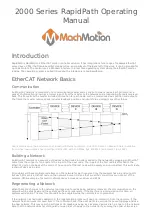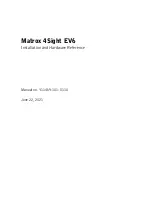
4
Service
The following instructions illustrate the
complete rebuilding of your Vickers
Series TZ hydraulic cylinder.
Refer to Figure 4 exploded view.
CAUTION
Before breaking a circuit connection,
make certain that power is off and
system pressure has been released.
Lower all vertical cylinders, discharge
accumulators, and block any load
whose movement could generate
pressure. Plug all removed units and
cap all lines to prevent the entry of dirt
into the system.
Required tools
Spanner wrench
Adjustable wrench
Soft brass tool
Thin tool
Copper padded vice
Rubber mallet
Torque wrench
Replacing rod seals
1. Once the cylinder is removed from
service, fully retract the piston rod
and remove all port connections.
Drain any hydraulic fluid by manually
cycling the cylinder. Large cylinders
can be carefully cycled with air
pressure.
2. The Quick Change rod cartridge
allows rod seal replacement without
disturbing the tie rods. Remove any
burrs from the wrench flat area of the
piston rod. Place the cylinder in a vice,
rod end up if possible. Remove the
rod cartridge by rotating it
counterclockwise with a spanner
wrench or by removing the retainer
screws on larger rod sizes. (If an
appropriate spanner wrench is not
available, service is best performed by
disassembling the entire cylinder. The
cartridge can then be removed by
placing a bar such as a square
shanked screw driver in the cartridge
slots, after removing the rod from the
head.)
3. Remove the rod seal from the
cartridge by carefully prying it out of
the groove with a dull brass (or other
soft material tool.)
4. Remove the elastomer wiper from
the outer most groove by carefully
prying it out of the groove with the
dull brass tool.
5. The non-metallic wear band can be
removed from the cartridge in a
similar fashion.
6. Lightly lubricate the new rod seal,
wear band and wiper. Install them in
the cartridge as shown in Figure 2.
Carefully lead the outside sealing
edge into each groove. Be careful
not to damage the seal or wiper.
Rod seal
Wiper
Wear band
Figure 2.
7. Carefully replace the cartridge on the
rod so that seal or wiper lips are not
damaged when placing them over
the piston rod. Threaded cartridges
should be turned clockwise and
tightened with a spanner wrench.
8. The bolt on cartridges on larger rods
is retained by the retainer plate.
Slide the retainer plate into position.
Replace the retainer screws, and
tighten in a cross sequence pattern.
Torque to the values shown in
Table 2.
Bore
(in.)
Rod
(in.)
Torque
(ft. lb.)
(N.m)
5
3 & 3
1
/
2
5
3 & 3
1
/
2
34
45
6
3 & 3
1
/
2
34
45
6
3 & 3
1
/
2
4
52
70
7
3 & 3
1
/
2
34
45
7
3 & 3
1
/
2
34
45
4 & 4
1
/
2
26
35
4 & 4
1
/
2
26
35
5
52
70
8
3
1
/
2
34
45
4 & 4
1
/
2
26
35
4 & 4
1
/
2
26
35
5 & 5
1
/
2
52
70
5 & 5
1
/
2
52
70
Table 2.
Complete rebuild
1. Repeat steps 1, 2, 3, 4 and 5 in
Replacing rod seals section.
2. Remove the tie rod nuts, loosening
in a cross sequence pattern.
Carefully remove the cap or head
from the tie rods and inspect for
damage or signs of contamination.
3. Remove the cylinder body from the
head/cap. Slide the piston rod
assembly out of the cylinder body. It
is not normally necessary to remove
the tie rods if threaded into a tapped
head or cap for servicing, unless the
tapped head or cap is mechanically
damaged.
4. The piston does not have to be
removed from the rod for normal
piston seal replacement. The piston
seal can be removed by inserting a
thin tool under the seal and running it
around the circumference of the
piston. The elastomer energizer
under the face seal should also be
removed.
5. Remove the nonmetallic wear band
which simply snaps into the groove
on the piston’s outer diameter.
6. If piston removal is required, clamp
the piston rod securely in a copper
padded vice to protect the rod finish.







































